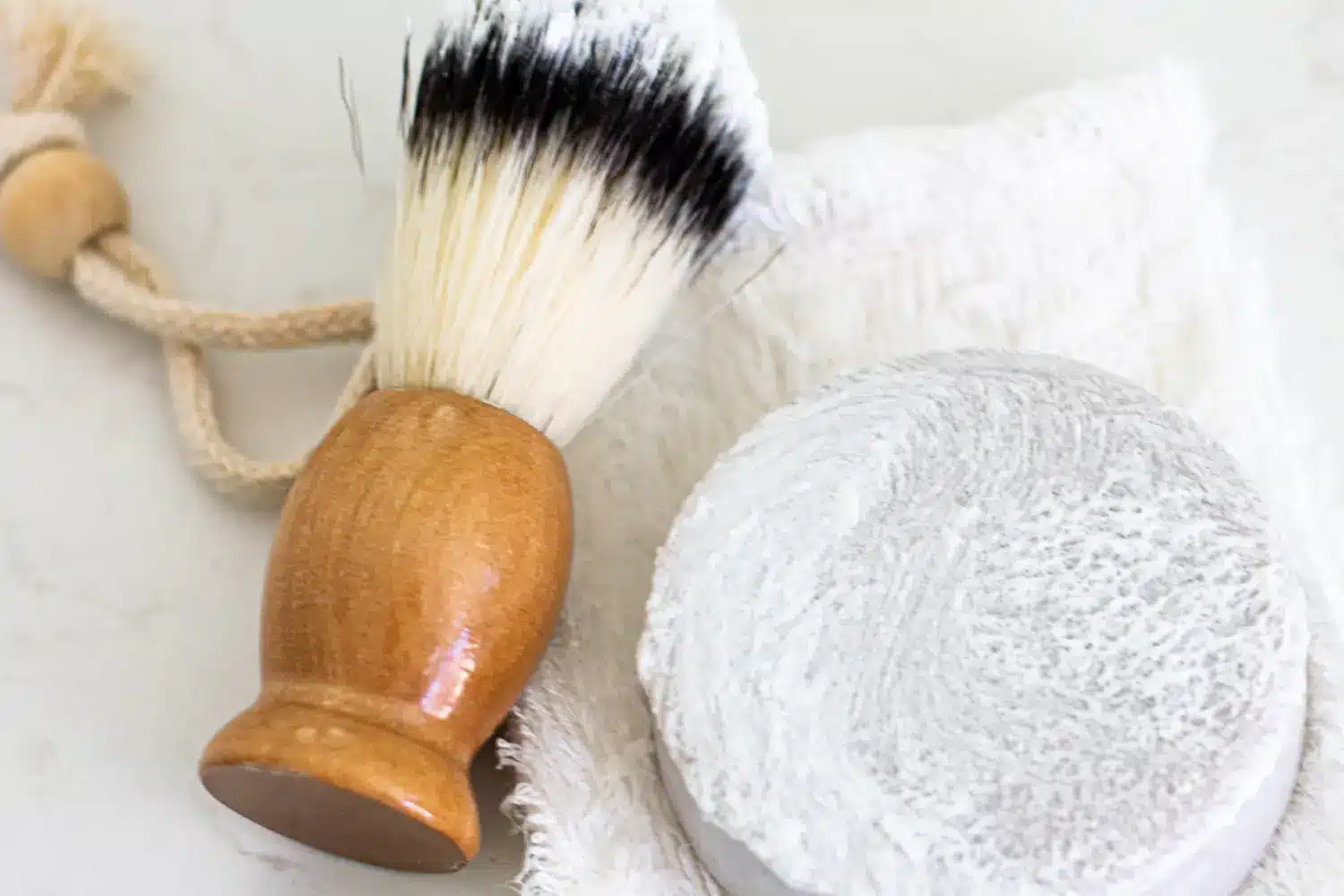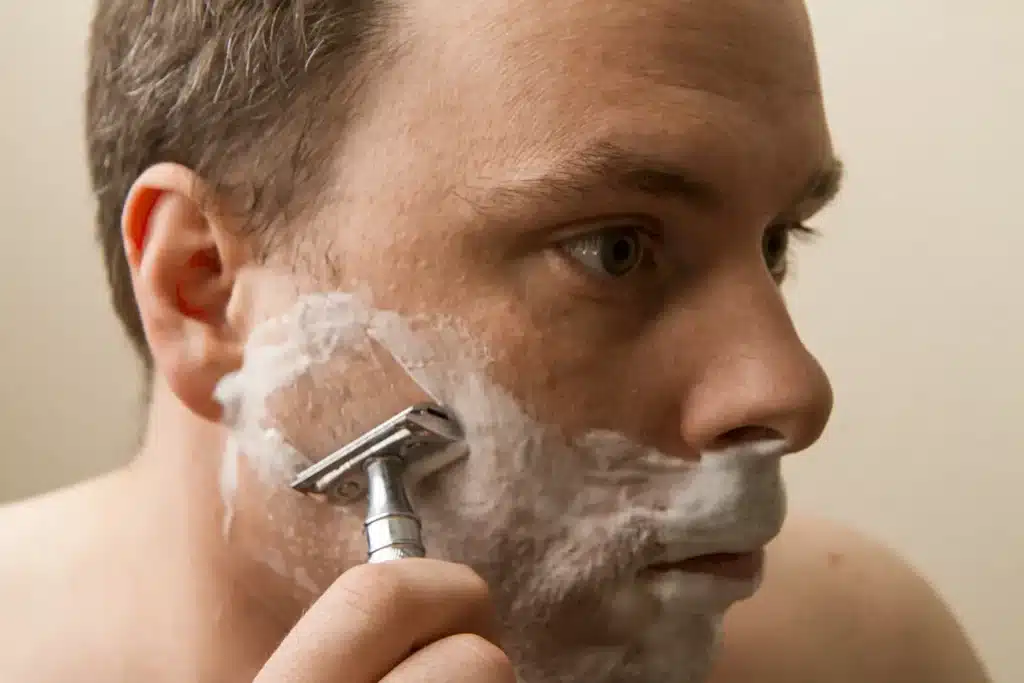When it comes to wet shaving with a safety razor, you might be wondering whether shaving soap or shaving cream would better suit your needs.
Both offer an array of benefits, but it’s essential to choose the right one based on your skin type, personal preferences, and shaving routine.
Truth be told, either option can provide a satisfactory shave. However, there are notable benefits and drawbacks to both. We’ll go over each, diving into specific details so you can make an informed decision.
Comparison Table
This table outlines the key similarities and differences on how shaving soap and shaving cream perform when used with a safety razor:
| Feature | Shaving Soap | Shaving Cream |
|---|---|---|
| Consistency | Hard, requires water and a brush to create lather | Soft, easier to lather with a brush |
| Lathering Process | Takes more time and effort to create a rich lather | Quicker and easier lather-building process |
| Longevity | Lasts longer due to solid form | Does not last as long as shaving soap |
| Cost | initial cost might be higher, economical in the long run | Varies based on brand, but typically more expensive per shave |
| Suitable for Travel | Less convenient due to size and accessories needed | More compact and travel-friendly |
| Ingredients | Glycerin, shea butter, essential oils, and botanical extracts | Similar to shaving soap, with variations in formulation |
| Performance & Protection | Excellent lubrication, cushion, and glide | Comparable performance; slightly easier to work with |
| Time and Skill Required | More time-consuming and requires skill to perfect lather | Beginner-friendly and a reliably good lather |
| Options | Hard soaps, triple-milled soaps, croaps | Traditional creams, shave gels, brushless creams |
| Recommended for Skin Type/Preference | Suitable for all skin types | Suitable for all skin types |
Why Shaving Soaps May Be Better For Safety Razors
As a wet shaver, you may have noticed that shaving soaps have been around for generations, with many of us reminded of our grandfathers using them. Where shaving soaps differ from creams is their consistency, as they are harder and require a bit of water and a brush to create a rich lather.
A high-quality shaving soap can offer a luxurious experience and excellent lubrication for your safety razor, providing a close and comfortable shave.
For men who appreciate the process of creating a lather and have a bit more time for their shaving routine, shaving soaps can be an ideal choice. Additionally, the solid nature of shaving soaps allows them to last longer than their cream counterparts, offering an economical advantage.
Want to learn how to shave better with a safety razor? We share 11 tips to elevate your shaving experience.
Different Types of Shaving Soaps

There are several types of shaving soaps available for wet shaving, including hard soaps, triple-milled soaps, and croaps (a cross between a cream and a soap).
- Hard soaps: typically require more time and effort to build a quality lather. These soaps are known for their long-lasting nature and excellent lubrication properties, making them a great choice for experienced wet shavers who have developed their lather-building technique.
- Triple-milled soaps: are a type of hard soap that has gone through a milling process three times to remove excess water and create a denser product. This results in a soap that is even more long-lasting and consistent in texture. The dense lather created by triple-milled soaps adds an extra layer of cushion and protection during your shave.
- Croaps: These soaps have a softer consistency, making them easier to lather and more beginner-friendly. However, they may not last as long as hard or triple-milled soaps. Croaps still provide excellent lubrication and cushion for a comfortable shave.
Did You Know: Folks with sensitive skin should look for shaving soaps that contain natural ingredients like shea butter, aloe vera, and glycerin, as these can provide additional soothing and moisturizing benefits for your skin. Fragrance-free and hypoallergenic options are also available for those who are prone to irritation or allergic reactions to scents and certain ingredients.
Do the Ingredients Within Shaving Soaps Impact Shave Performance?
High-quality shaving soaps often contain natural ingredients, including glycerin, shea butter, and essential oils, which provide moisture and protection during the shave. Glycerin is known to be a humectant, attracting water to the skin to keep it hydrated while also providing a smooth glide for the razor blade according to Healthline. Shea butter adds an extra layer of moisturizing properties, which can be especially helpful for those with sensitive skin.
Essential oils offer not only a pleasing aroma but also potential skin benefits depending on the oil used. While many claims about essential oils are anecdotal, some oils, like lavender and tea tree, have been found to have antibacterial and soothing effects on the skin according to a study by the National Institutes of Health.
However, some individuals may be sensitive to certain essential oils, so it’s important to patch-test a product before using it for the first time to avoid potential irritation.
Now do these ingredients directly impact shave performance? The answer is both yes and no. The primary function of shaving soap is to create a rich, protective lather that allows the razor to glide smoothly over the skin. In this sense, ingredients like glycerin and other humectants play a crucial role in achieving optimal shave performance by ensuring adequate lubrication and hydration.
On the other hand, factors such as shea butter and essential oils can indirectly impact shave performance by promoting healthier, more supple skin, which is more resistant to irritation, nicks, and cuts during the shaving process.
Pro Tip: The FDA does not regulate essential oils, so it’s crucial to purchase them from reputable sources and ensure they are of high quality.
Shave Quality
When it comes to performance, shaving soaps excel in providing a stable, cushioning lather that helps to protect the skin from the safety razor’s blade.
A high-quality shaving soap will also provide excellent slickness or glide, which enables the razor to move effortlessly across the skin without any tugging or resistance.
Some shaving soaps may also offer additional benefits, such as post-shave hydration and skin-soothing properties. These additional features help to ensure that your skin feels refreshed and well-cared for after the shaving process, reducing the likelihood of dryness, tightness, or any post-shave discomfort.
Drawbacks of Shaving Soaps

Time is the main drawback of using shaving soaps, as they require a bit more effort and skill in creating the perfect lather compared to other shaving products like creams and gels. Don’t be discouraged if your first few lathers aren’t perfect; it takes practice to master the technique.
Another potential drawback is the initial cost of investing in high-quality shaving soap, as well as the necessary accessories like a shaving brush and bowl. While they may provide a much cheaper option on a per-shave basis over time, the upfront expense can be off-putting for some. Keep in mind, though, that quality shaving soaps and accessories can last for months or even years with proper care and storage, making them a cost-effective investment in the long run.
Additionally, finding the right shaving soap for your skin type and preferences can be a challenge. To narrow down your options, look for reviews and recommendations from reputable sources, such as grooming experts or shaving forums. We particularly think forums like Badger & Blade and The Shave Den provide valuable insight and information from experienced wet shavers, which can help guide you in making an informed decision.
Lastly, shaving soaps may not be the best option for individuals who frequently travel or have limited space in their bathroom. Shaving soaps, brushes, and bowls can be bulky and delicate, making them less convenient to transport and store compared to more compact shaving creams or gels.
The Advantages of Using Shaving Creams with Safety Razors

While shaving soaps have a long-standing history, shaving creams have become popular for their ease of use and convenience. Quality shaving creams can provide excellent lubrication and a rich lather, ensuring a smooth and comfortable shave with your safety razor.
Types of Shaving Creams
There are various types of shaving creams available, including:
- Traditional shaving creams: Typically packaged in a tub or tube, these creams require a shaving brush to create a rich lather. Traditional shaving creams often contain skin-friendly ingredients like glycerin, essential oils, and nourishing botanical extracts. They tend to produce a more luxurious lather compared to their counterparts, providing excellent cushion and glide for the razor.
- Shave gels: Offering a more transparent lather, shave gels make it easier to see the area being shaved, which can be helpful for precise shaving and detail work. Gels can be more beginner-friendly and may require less technique than traditional shaving creams to achieve a suitable lather. However, some shave gels may contain synthetic ingredients and lack the moisturizing properties of traditional shaving creams.
- Brushless shaving creams: These creams are designed to be applied with your hands and do not require a shaving brush. They can be more time-efficient and convenient but may not produce the same rich lather and cushion as traditional shaving creams.
Ingredients to Look For in Shaving Creams
Like shaving soaps, high-quality shaving creams contain beneficial ingredients that can enhance your wet shaving experience. Some common ingredients include aloe vera, which helps soothe irritated skin and reduce inflammation, as well as shea butter and glycerin for added moisture and glide according to the American Academy of Dermatology.
In contrast, it’s best to avoid shaving creams containing alcohol, synthetic fragrances, and harsh chemicals, as these can potentially cause skin irritation and dryness, particularly for those with sensitive skin.
Did You Know: Some shaving creams contain natural exfoliants such as oatmeal, which can help gently remove dead skin cells, cleanse the skin, and reduce inflammation.
Shave Quality of Shaving Creams and Safety Razors

Performance-wise, a high-quality shaving cream offers excellent lubrication, protection, and glide for your safety razor, ensuring a smooth and comfortable shave. The lather created by these creams is typically thick, rich, and cushioning, providing a barrier between the skin and the razor blade for a close, irritation-free shave.
Some wet shaving enthusiasts find that shaving soaps offer slightly better lubrication and slickness compared to shaving creams, resulting in a smoother glide for the safety razor.
Where they differ from shaving soaps is the ease and speed at which they produce a lather, making them more beginner-friendly and time-efficient. This makes shaving creams an attractive option for those with a fast-paced lifestyle or limited time for their daily grooming routine.
Pro Tip: To get the most out of your shaving cream, make sure to use a quality shaving brush with soft bristles, as this will help create a rich, evenly distributed lather and gently exfoliate the skin, lifting the hairs for an optimal shaving experience.
Drawbacks of Using Shaving Creams With Safety Razors
While shaving creams offer many advantages, they are not without their drawbacks. When paired with safety razors, some potential issues could arise.
One of the main disadvantages is that they may not last as long as shaving soaps on a per-shave basis, making them slightly less economical in the long run.
Moreover, due to a more extensive range of options, choosing the right shaving cream for your skin type and preferences can be a challenging task.
Options like traditional creams, shave gels, and brushless creams all have their unique features and potential drawbacks. This can lead to a daunting trial-and-error process before finding the perfect cream that suits your needs. When you factor in the many different types of razor blades available for safety razors, the process becomes even more complex.
Quality shaving creams also tend to be relatively more expensive than average creams, which may deter some individuals from investing in a high-quality product. However, it’s important to note that using a better shaving cream can significantly enhance your shaving experience and help avoid potential skin irritation and discomfort that may result from using lower-quality alternatives.